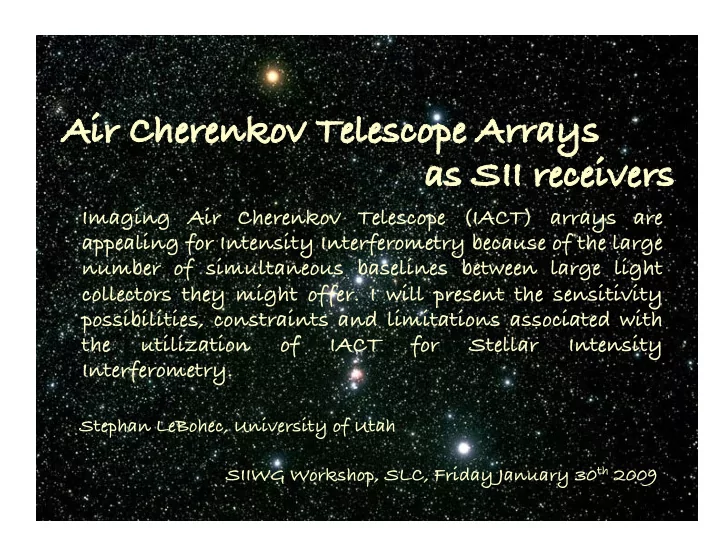

Air Cherenkov Telescope Arrays Air Cherenkov Telescope Arrays � � � � � � � � � � � � � � as SII receivers � as SII receivers � Imaging Air Cherenkov Telescope (IACT) arrays are appealing for Intensity Interferometry because of the large number of simultaneous baselines between large light collectors they might offer. I will present the sensitivity possibilities, constraints and limitations associated with the utilization of IACT for Stellar Intensity Interferometry. � Stephan LeBohec, University of Utah � SIIWG Workshop, SLC, Friday January 30 th 2009 �
1963 2006 J.E. Grindlay, 1975 � 2008 we could start using � uses the Narrabri telescopes � TeV gamma ray telescopes � to observe Cen A in gamma TeV as Intensity Interferometer receivers � energies �
NSII: � Two telescopes � � � � on circular tracks � * No signal delays � * Range of baselines (10m - 200m) �
HESS 12m telescope array (Namibia) HESS 12m telescope array (Namibia) � VERITAS 12m telescope array (Arizona) VERITAS 12m telescope array (Arizona) �
VERITAS as an interferometer �
A possible design for CTA A possible design for CTA � Cherenkov Telescope Array Cherenkov Telescope Array � 4656 baselines � 47 baseline lengths � 600m 2 100m 2 Construction: 2012 �
CHARA CHARA � “Imaging the surface of Altair” “Imaging the surface of Altair” � J.D. Monnier, et al., 2007, J.D. Monnier, et al., 2007, � � � � Science, 317, 342. Science, 317, 342. �
CTA CTA � SII SII � imaging imaging � capabilities capabilities � See Paul Nunez phase See Paul Nunez phase and image reconstruction and image reconstruction �
SII receiver � convertion � of IACTs � (Interferometric observation � during full moon) � Camera � shutter � integration �
Geometrical optics digression � 12m f/1 Davis-Cotton � � � � � � 0.05 o PSF = 10mm � 10nm OBW = Collimation to ~5 o � � � � f/1 Collimator ø=10mm/tan(5)=110mm � 5 o collimation � 110mm concentrator � 110mm collimator � 110mm analyzer � Davis-Cotton � From f/1 �
Parabolic optics preserves timing � Camera �
Davis-Cotton optics used for IACT � � in order to minimize PSF degradation toward the edge of the fov � Camera � 12m Davis-Cotton f/1 = 4ns dispersion � � � � � � ~100MHz signal bandwidth limitation �
Sensitivity? Sensitivity? � A=100m 2 � α =30% � Δ f=100MHz � T=5 hours � S/N=5 � For | γ | 2 =0.5 � n ~ 5.5m V & Δ r=14% � @ 3.7m V , Δ r=3% � This is with just one baseline!!! �
With many baselines... With many baselines... � PSF PSF � limitation: limitation: � 0.05 o o -> 9.6m 0.05 -> 9.6m V � 0.01 o -> 13.0m 0.01 -> 13.0m V �
So there is an interesting potential . . . � � � � � Now what? � Implementing SII with IACT arrays � Two types of considerations � �� 1) � SII specific technology � �� 2)IACT facility interfacing and adaptation �
1) SII specific technology � � * Optics � � * Photo-detectors � � � see David Kieda’s presentation � � * Signal transmission � � � see Michael Daniel’s presentation � � * Correlation � � � see presentations by � � � � Erez, Dainis, Giampiero, Stephan,… � IT SEEMS WE’VE GOT EVERY THING ALREADy! �
2) IACT facility interfacing adaptation � � * Focal plane implementation � � � camera shutter = space and freedom � � � � CTA in need of specifications � � � � � (volume, weight, power, …) � � * Parabolic instead of Davis Cotton � � - Not likely to happen (larger f/d & cost) � � - from 100MHz to 1GHz SN x √ 10 = 1.2m v � � - 1GHz implies 100ps timing �
2) IACT facility interfacing adaptation � • * Should redundancy be reduced? � � % Analysis (higher order or not) � • � % Science (low order imaging or imaging)? � NORTH � SKA � SOUTH �
2) IACT facility interfacing adaptation � � * Add a couple of telescopes � � � � � � � � for shorter baselines? � � � � Should they be smaller so as to � � � � � � � � not resolve bright stars? � Aliasing �
2) IACT facility interfacing adaptation � � * Real estate issues � � � � - Conduits � � � � - Building (correlator location, � � � � � � � � � control room, … ) � � � � - Observation programming � � � � - Observing modes � � � � � � � �
Conclusions � � * SII with IACT: real science potential � � � � Bright moon time � � � � IACT science output increased � � � � Synergy Optical % High Energy � � * Technology already available � � � � Choices to be made � � � � Several ongoing prototyping � � * CTA is going to happen � � � � Construction starting 2012 � � � � Now is the time to get involved �
Hardware budget: � � � A shot in the dark: � � Secondary optics= $5,000 x 97 � � Photo-detector = $2,000 x 97 � � Signal transfer = $1,500 x 97 � � Correlators = $200 x 4656 � � Computing � = $20,000 � � TOTAL =$1,775,700 � � � � � � Say $2M �
Recommend
More recommend